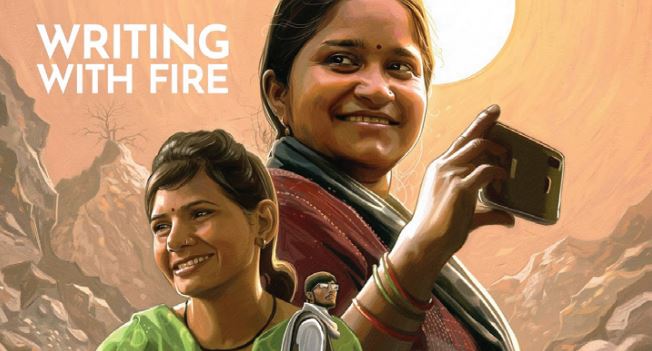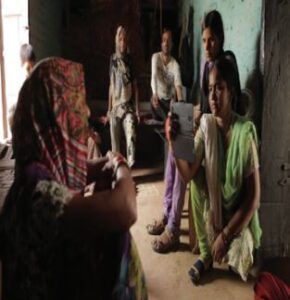The term Khabar Lahariya roughly translates to “news waves.” It has been in existence for nearly 20 years but a few cocooned in their air-conditioned apartments or riding around in their luxury cars have heard this name or seen the paper which has now gone digital in sync with the changing times.
Suddenly, it has become infra dig to discuss this unique media outlet because a documentary made on this experiment has just been shortlisted by the Oscars committee this year. The name of the film is Writing with Fire, an apt name for a group of gutsy women, all Dalits, who decided to start their own newspaper.
Writing with Fire was premiered at the Sundance Film Festival where it won the Special Jury Award and the Audience Award. It is now journeying through many prestigious festivals across the map. Rintu Thomas and Sushmit Ghosh, a real-life husband and wife who live and work in Delhi, are going places with this film, a bold choice of subject for a documentary in the present times. The film focusses on chief reporter Meera Devi who could be said to be the founder of Khabar Lahariya and younger journalist Suneeta Prajapati, observing them at work and taking us along the journey of their reportage to take a look into lives behind the newspaper as they run around for stories.
The film follows the journey of Dalit women in the Bundelkhand region of Uttar Pradesh, who work for a weekly newspaper, Khabar Lahariya. It also fleshes out the back stories of the three women who are articulate and forthright in unspooling their lives. Khabar Lahariya (Waves of News) was founded in 2002 by Dalit women whose community members suffer extreme discrimination because they are “Dalits”. The girls and the women are more open to oppression than their men. Meera Devi, married at 14, strives to rise above her status and educate herself. Meera’s husband, Shivbaran, states in the film, “I never expected them to achieve anything.”
“Dalithood characterises the exploitation, suppression and marginalisation of the lower castes by the social, economic, cultural and political domination of the upper caste Brahmanical order” – the way Dr. Babasaheb Ambedkar defined the word “Dalit” long before we included it in our common lexicon, according to Tapan Basu. (Translating Caste. New Delhi: Katha, 2002.)
These women broke all taboos against Dalits in general and Dalit women in particular by bringing out a magazine containing every kind of news that are/were not covered by mainstream publications. This, till date, is the only paper brought out exclusively by Dalit women in this country. Suneeta has also redefined herself, taking her childhood experience of working in an illegal mine and using her community connections to pull back the curtain on ongoing criminality.
A financial crisis at home led Shyamkali to Khabar Lahariya in 2010. The inhibitions within her and outside were similar, “kyuki ghar se kabhi baahar nahi jaate the, aur yeh auraton ka kaam nahi hai. Itne purushon ke beech ek aurat!” (I had never stepped out of the house before this. I was nervous because I was about to step into a male domain.)
A decade later, armed with a smartphone and steely determination, she is KL’s only reporter from Mahoba. Her quest for truth has taken her to different places. Shyamkali is another woman who, along with her colleague, is risking her life to report the truth. The film mainly revolves around these three women who rose from the trap of their lives to take cudgels for those who are not written about by the mainstream media.
“We are beyond delighted. This is a massive moment for us and for Indian cinema… This film is about fearless Dalit women journalists who are redefining what being powerful means, quintessentially the story of the modern Indian woman,” co-director Ghosh said. He said that he and Rintu got the news directly from the television screen while watching the names of the films shortlisted by Oscars 2022.
Walking with Water recounts how the newspaper brings to the fore incidents, events, people and such stories that would not be brought across by the mainstream media and that is the very purpose of the paper as well as of the filmmakers who decided to put across their story on film.
The newspaper is bilingual – in Hindi and in English, the editorial classification is divided among – Development, Gender & Caste, Youth & Culture, Bundelkhand & Beyond and Politics.
Said Rintu Thomas in an interview, “We never imagined a Dalit woman would be actually printing, reporting, and distributing a newspaper that she co- created. We looked them up and a friend connected us. We wanted to know more. We caught them at the time when they were transitioning into this new realm of digital and understanding being in front of and behind the camera. That was an interesting dynamic for us. We were filming them as they were filming (stories). It took the director duo around three years to research the organisation, speak to the women involved and finally, get down to make the film.
Ghosh pitches in to elaborate. “When Meera goes to a Dalit village to report on what it means to be Dalit in those parts of the country, it sets up her own personal story. She talks about her children and how they are made fun of in school. So, the political and the personal always went together. We always wanted it to be layered, intersectional. When Suneeta goes to report on the murder story, you see her brand of journalism and you see the popular mainstream male- dominated brand of journalism picking up juicy bits, like vultures. But immediately after that scene, you have Suneeta talking about what it means to be a woman. So, the idea was picking stories that they have covered that represent what the newspaper does, the value systems, the journalistic ethics of the paper, and linking it to the personal narrative to each of our characters — so it was both macro and micro.”
Khabar Lahariya went digital not very long ago to keep pace with the technological changes happening on the information roadway so one can just log into their website and see what they are all about. So, it now defines itself as a “Digital Rural News Network.” Independent and Public-Spirited Media Foundation has provided part financial support to Khabar Lahariya for the purpose of reporting and publishing stories of public interest. IPSMF does not take any legal or moral responsibility whatsoever for the content published by Khabar Lahariya on its website or on any of its other platforms. The newspaper comprises 24 female journalists.
They have reached over 150 million views on YouTube and have started collaborating with national media groups to further expand their reach. On their watch, violent crimes are being brought to light and prosecuted, faulty roads are being fixed and rural communities are receiving electrical and plumbing connections. Some individual women’s lives have also changed for the better and you can read these stories on their website or on YouTube.
Writing with Fire shows how young women journalists are learning to use a smartphone to make videos. They are willing to take every step to adapt themselves to technological changes that take place every day. The best part of their story is that through this struggle, they have learnt to balance between home and work.


 Writing with Fire – The documentary won the Special Jury Award and the Audience Award at the Sundance Film Festival
Writing with Fire – The documentary won the Special Jury Award and the Audience Award at the Sundance Film Festival A shot from Writing with Fire
A shot from Writing with Fire